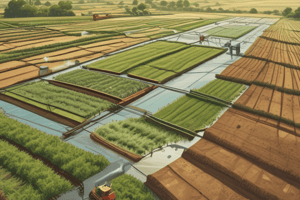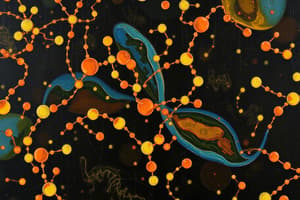Podcast
Questions and Answers
What is the significance of selecting the correct size for the main, submain, and lateral pipes in a micro-irrigation system?
What is the significance of selecting the correct size for the main, submain, and lateral pipes in a micro-irrigation system?
- It determines the type of chemicals that can be used.
- It affects the aesthetics of the irrigation layout.
- It is crucial for matching flow rates from the water source. (correct)
- It is only important for above-ground installations.
Which component is NOT typically found in a micro-irrigation system?
Which component is NOT typically found in a micro-irrigation system?
- Soil compaction monitor (correct)
- Water distribution system
- Pump and power unit
- Backflow prevention device
When might a backflow prevention device be necessary in a micro-irrigation system?
When might a backflow prevention device be necessary in a micro-irrigation system?
- For systems that rely on solar-powered pumps.
- If chemicals are injected into the water. (correct)
- When using only municipal water supply.
- In drip irrigation systems exclusively.
Which type of power units can be used for micro-irrigation systems?
Which type of power units can be used for micro-irrigation systems?
What should be considered when determining the type of pump for a micro-irrigation system?
What should be considered when determining the type of pump for a micro-irrigation system?
What role do filters play in a micro-irrigation system?
What role do filters play in a micro-irrigation system?
Which type of filter is composed of fine gravel or coarse quartz sand?
Which type of filter is composed of fine gravel or coarse quartz sand?
Which component is primarily responsible for maintaining sufficient pressure in a micro-irrigation system?
Which component is primarily responsible for maintaining sufficient pressure in a micro-irrigation system?
What is a common application method for adding fertilizer in a micro-irrigation system?
What is a common application method for adding fertilizer in a micro-irrigation system?
What is the diameter range of pipes and tubes used in the distribution system of a micro-irrigation system?
What is the diameter range of pipes and tubes used in the distribution system of a micro-irrigation system?
Study Notes
Components of Micro Irrigation System (MIS)
- Micro-irrigation systems are often described as branching systems.
- Branches are named such as main, submain, and lateral.
- It is important to choose the correct size of pipes for each branch to match the flow rate.
- Important components include a pump and power unit, a backflow prevention device, a filter, a water distribution system, and devices for controlling water volume and pressure.
- A direct connection is possible if the water source is from a city/municipal/rural water supply.
Pumps and power unit
- Pump size is determined by the amount of water required, desired pressure, and its location in relation to the distribution network.
- Electric power units or internal combustion engine driven pumps are both suitable.
- Electric powered pumps can provide consistent water pressure.
Micro-Irrigation System Components
- Electric power units are preferred for micro-irrigation systems because they are easy to automate
- Micro-irrigation systems use filters to remove sand and suspended particles, but not dissolved minerals, bacteria, or algae
- Common filter types are screens, disk filters, and sand filters.
- Water distribution system consists of pipes and tubes ranging in size between 12 mm to 150 mm in diameter
- Water from the main pump is transported to the field's edge then to submains and laterals for ultimate delivery to emitters
- Control head unit components:
- Pump/Overhead Tank: Ensures sufficient system pressure
- Fertilizer Applicator: Used to introduce fertilizer into the pressurized irrigation system
- Filters: Prevent blockages and clogs for efficient and trouble-free operation
- Types of filters:
- Gravel or Media Filter: Consists of fine gravel or quartz sand (1.5-4 mm in diameter) placed within a cylindrical tank to remove algae and other organic matter.
Studying That Suits You
Use AI to generate personalized quizzes and flashcards to suit your learning preferences.
Description
Test your knowledge on the essential components of Micro Irrigation Systems (MIS). This quiz covers various aspects including the types of branches, pump specifications, and necessary control devices. Understand how to choose the right components to optimize water distribution.




